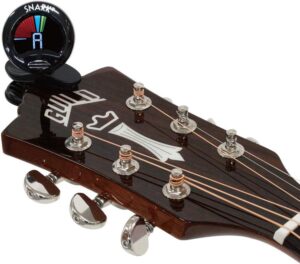Tune Your Guitar up Before Practice
Tuning your guitar like a pro is a crucial skill that every guitarist—beginner or pro—needs to master. A well-tuned instrument sounds better, plays more accurately, and makes your practice or performance more enjoyable. The best part? You can tune your guitar like a pro in under five minutes with the right method. Whether you’re gearing up for a gig or just strumming at home, here’s a quick and efficient guide to get you in tune fast. If your going to play a guitar, it might as well be in tune.
The Fastest Way To Tune Your Guitar Like A Pro: Using a Digital Tuner
The easiest and most precise way to tune your guitar like a pro is with a digital tuner. These affordable devices are user-friendly and perfect for all skill levels. Here’s how to do it:
- Start with the Low E String: Attach your tuner to the headstock (or place it nearby if it’s a pedal tuner). Pluck the thickest string—the low E—and adjust the tuning peg until the tuner shows it’s in tune.
- Move Through the Strings: Repeat the process for the A string, then D, G, B, and finally the high E string.
- Double-Check: Adjusting one string can slightly detune the others, so revisit each string to ensure they’re spot-on.
This method is lightning-fast and reliable, taking less than five minutes once you get the hang of it.
Truefire is offering an amazing special offer for full access to all lessons and songs!
Beyond the Basics
While a tuner is your go-to for speed, learning to tune by ear is a skill worth developing. It takes practice, but it’s a game-changer for any guitarist. If you’re eager to sharpen your ear and boost your overall playing, the best online guitar lessons offer expert guidance and structured exercises to accelerate your progress.
In standard tuning, the guitar strings are tuned as follows:
- 6th string on top(thickest string) is tuned to E
- 5th string or second from the top is A
- 4th string is D
- 3rd string is G
- 2nd string is B
- 1st string on the bottom is also E but at a higher octave than the 6th string.
Start On Pitch – Get A Reference
If you’re going to practice tuning by ear, you should have a reference to get your initial pitch correct (later, you may develop the skill to recognize the correct pitch by ear.) The reference note could be from another instrument such as a piano or another guitar.
If you’re going to use another “in-tune” guitar, you can match the pitch of your guitar strings to the related strings on the other guitar.
If you don’t have an “in tune” instrument at hand, you’ll need a tuning fork, pitch pipe, or electronic tuner that will sound an audible note that you can tune your guitar to by ear.
Get Low E In Tune First
Get your first string in tune by adjusting your guitar’s low E string (thickest string) to match the pitch of your reference E note. Then you can tune the remaining strings to the low E by following the procedure below:
- Press the 6th (E top) string at the 5th fret
- With the 6th string depressed at the 5th fret, pick the 6th and 5th (A) string
- Adjust the pitch of the 5th string to match the pitch of the fretted 6th string.
- Press the 5th string (second from top, A string) at the 5th fret, and tune to the 4th (D) string to the pitch of the fretted 5th string
- Repeat this process for the 4th (D) to 3rd (G) string
- When you tune the 3rd (G string) to the 2nd (B) string, you must depress the 3rd string at the 4th fret, and tune the 2nd string to pitch.
- Press the 2nd string (B) at the 5th fret, and tune the 1st bottom (E) string to pitch.
- Go over everything again. Sometimes the string tension on one string affects the tuning of the others.
I know. It sounds very complicated, but once you get the hang of it, it’s really not that difficult. The more you practice the easier it will get! (or just use an electronic tuner!) 😉
Tuning by ear can be tricky and takes some practice, but it’s a skill worth cultivating as it will help you recognize when your instrument is out of tune, and in the long run make you a better musician.
Clip-on Tuners
If tuning by ear sounds too complicated, great products are available to help you get in tune quickly. Clip-on tuners are very inexpensive and suitable for both acoustic and electric guitars. They simply clip onto your guitar’s headstock and indicate if the string you’re playing is in tune or not.
Tuner Pedals (For Electric Guitars)
If you play electric guitar, another option is an inline tuning pedal. Plug your guitar into a tuning pedal before your amp or pedal board, when you activate the pedal a display shows you if the string you’re playing is either flat or sharp. The pedal will help you tune your guitar flawlessly. I have a Korg tuner on my pedal board and love it because it’s quick, accurate, and very easy to see, even on a dark stage. Another advantage of using tuning pedals is that many of them, such as my Korg, allow you to set them to mute the guitar output while you’re tuning so that your audience (or your neighbors!) don’t have to listen to you while you’re tuning your strings.😁
Final Note
With a bit of practice, tuning becomes second nature. Keep your guitar in tune to make every chord and riff sound its best—your ears (and audience) will thank you!
Please Subscribe to our newsletter!
Thank you for visiting our site!
We're so glad you are interested in learning to play guitar, and make music! Please take a moment and subscribe to our newsletter, where we will provide tips, tricks, new content, and insights about playing, and all things guitar!
tricks, new content, and insights about playing, and all things guitar!
We look forward to hearing of your success! Start playing today!



